Dr Arthur Karagiannis, a highly experienced Cataract Surgeon, established Cataract Centre SA, to reflect the highest standard of care that is required to achieve the best outcome for patients undergoing cataract surgery. As a highly experienced cataract surgeon with over 17 years experience, Dr Karagiannis understands that each patient will have different expectations and needs with respect to cataract surgery. All patients are informed of the lens options that are available, including bespoke multifocal lenses designed to reduce the dependence of reading glasses.
What is a cataract?
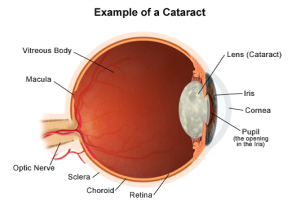
A cataract is a gradual clouding of the crystalline lens inside the eye. The lens sits behind the iris, the coloured part of the eye. This clouding tends to decrease vision over time and will continue doing so until a person cannot see out of the affected eye at all.
What causes cataracts?
Cataracts usually occur as a normal process of ageing. Most people will get cataracts at some stage in their life. Although it is much more common in older people, younger people can get cataracts. This usually occurs for a secondary reason such as an eye injury, taking specific long term medications such as steroids, long term exposure to the sun, excessive smoking, some health conditions such as diabetes and numerous other factors. In many cases both eyes will show signs of cataract.
What are the symptoms?
Most people do not notice any changes to their vision until the cataracts have progressed to a moderate level. This is due to the fact that cataracts usually develop over months to years. Once vision starts to become affected, patients typically notice difficulty with detailed tasks, sensitivity to light, a “film” or “fog” across their vision, “shadowing” of objects, difficulty with night vision, and sometimes even distortion or double vision. Cataracts do not cause pain in or around the eye, or headaches.
How are cataracts treated?
The only way to treat a cataract, is to remove the cataract with surgery.
Surgery is carried out when a patient’s vision has started to become affected by the cataract(s). Surgery involves removing the cloudy cataractous lens, and replacing it with an artificial intraocular lens. If both eyes are affected, they are usually operated a few weeks apart. Surgery is not usually performed on both eyes on the same day. After cataract surgery is performed, some patients find that they do not need to wear glasses, or may only need them for near duties, e.g. reading and/or computer work.
The need for glasses post-surgery will vary depending on what type of intraocular lens is selected.
What happens before surgery?
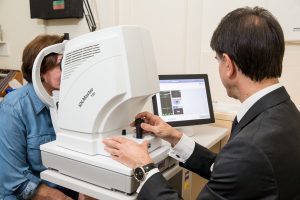
Prior to the surgery, measurements need to be taken of the eyes to determine what intraocular lenses are required to replace the patient’s own cloudy lens. As everyone’s eyes are different, the artificial lenses required to replace the cloudy lens will be different as well. Just as no one can wear another person’s glasses and see clearly with them, the intraocular lens needed for one person may not give an optimal visual outcome for another person.
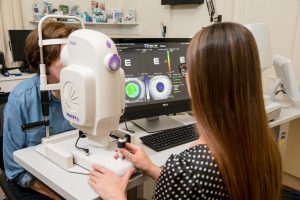
Indeed, the intraocular lens required is usually different even between the two eyes of the same patient.
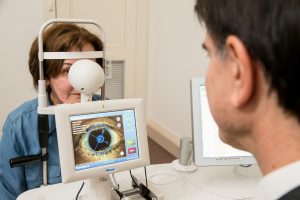
Dr Karagiannis uses state of the art advanced diagnostic technologies to measure patient’s eyes for cataract surgery. There are numerous machines used in the measurement process.
What does the surgical procedure involve?
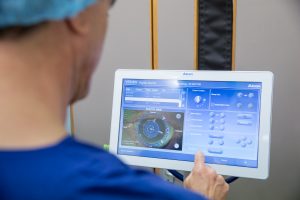
Dr Karagiannis has personally performed more than 10,000 cataract surgeries, as well as, other types of eye surgeries. The operation is carried out at the BURNSIDE WAR MEMORIAL HOSPITAL, as a day procedure under local anaesthetic with some sedation.
Note: Dr Karagiannis also consults in the Riverland and Mildura and operates at the Riverland General Hospital, Berri, SA and The Mildura Private Hospital, Victoria.
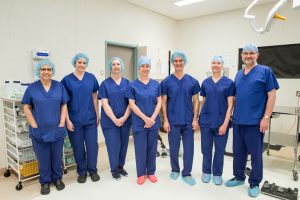
Once the anaesthetic has taken effect, a small incision is made at the edge of the cornea. Specialised surgical instruments are passed through this small incision and through the pupil to perform the surgery. Firstly, a small area of the front capsule (the “shell” that encases the cataract) is removed. Then, the cataract is broken up into small pieces and removed from inside the capsule. Lastly, the artificial lens specifically chosen for your eye is inserted to sit inside the capsule. No stitches are required as the first incision is very small. After this, the eye is generally padded overnight.
What will postoperative care involve?
After the surgery, patients are given specific anti-inflammatory and antibiotic eye drops to use for a prescribed period, to help aid with the healing process. Postoperative appointments with Dr Karagiannis are organised to monitor the healing process and visual progress after the surgery.
What if I have a postoperative concern after hours?
After the surgery, you will be provided Dr Karagiannis’ mobile phone number so that if you have any concerns immediately after your surgery and outside our regular office hours you can contact him.
What outcome can you expect?
We recommend an appointment with your optometrist at least five weeks after the surgery to update your glasses, if required.
Recovery time depends on each person, but most people can expect to feel both eyes have returned to normal within the first 3 weeks. A bit of temporary discomfort and blurriness is to be expected after the surgery and is nothing to be concerned about. If a person has other eye issues which are interfering with their vision, the visual outcome after surgery may not be as they would have liked, but it is usually clear before you undergo surgery what other eye issues you may have that could impact the visual outcome. Most patients are able to drive and return to work 48 hours after the surgery.
Can young people get cataracts?
Yes. Although it is much more common in older people. Occasionally, you can even be born with cataracts.
Can a cataract return after surgery?
Once the cataract has been removed it cannot return.
However, the original lens capsule which now holds the artificial lens, can develop scar tissue over time. This can sometimes mimic the visual symptoms of a cataract. This scar tissue can be treated easily and painlessly with the use of a YAG laser. This is carried out at Dr Karagiannis’ consulting rooms.
Can I drive after cataract surgery?
You will NOT be able to drive the day of your surgery or for 48 hours afterward. This is a requirement of the hospital and also because your vision may still be blurry from the surgery.
We recommend you DO NOT drive after your consultation appointments either because you may have dilating drops put in your eyes. These drops dilate your pupils and may take 1-2 hours (sometimes longer) to wear off.
Will I need glasses after my cataract surgery?
Depending on what type of artificial lens is chosen. Dr Karagiannis uses multifocal intraocular lenses, for those patients that are suitable, to reduce their dependence of glasses. His preferred multifocal lens is the Oculentis, asymetric refractive multifocal.
Click here for more information Lentis Comfort Patient Leaflet and MPlus Patient leaflet
How long will I be in hospital?
Cataract surgery is a day surgery procedure only. You will likely be at the hospital for 2-3 hours.
Do you have further questions?
We are here to help! Please contact our friendly team on (08) 83326362. We will be happy to discuss any concerns you may have to help you feel at ease with your surgical decisions.




